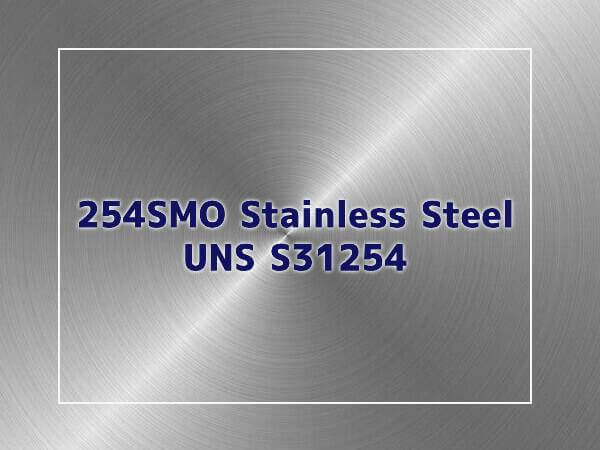
254 SMO stainless steel is a Super Austenitic stainless steel grade, it was originally developed for use in seawater and other aggressive chloride-bearing environments. This grade is considered a very high-end austenitic stainless steel, these specific levels of Cr, Ni, Mo, and N in this “super austenitic” chemical makeup allow UNS S31254 to combine impact toughness resistance to corrosion cracking, with pitting and crevice corrosion resistance.
UNS S31254 is often referred to as a “6% Moly” grade due to the molybdenum content; the 6% Moly family can withstand high temperatures and maintain strength under volatile conditions.
254 SMO Chemical Composition
The chemical composition of stainless steel 316L mainly comprised of between 19.5% and 20.5% chromium, 17.5% to 18.5% nickel, 6% to 6.5% molybdenum, and 0.18% to 0.22% nitrogen.
| Alloy | C | Si | Mn | P | S | Cr | Ni | Mo | Cu | N |
|---|---|---|---|---|---|---|---|---|---|---|
| 254SMO | 0.020 | 0.80 | 1.00 | 0.030 | 0.010 | 19.5-20.5 | 17.5-18.5 | 6.0-6.5 | 0.5-1.0 | 0.18-0.22 |
254 SMO Mechanical Properties
| Alloy | Tensile Strength Minimum, MPa (Ksi) | Yield Strength Minimum, PMa (Ksi) | Elongation In 2″ Minimum | Hardness, Max Rockwell B |
|---|---|---|---|---|
| 254SMO | 690 (100) | 310 (45) | 35% | 96 |
Alloy 254 SMO is substantially stronger than the common austenitic grades, with strength nearly twice that of 300 series stainless steel.
254 SMO Physical Properties
| Density | Modulus Of Elasticity | Thermal Exp. At 100 °C | Thermal Conductivity | Thermal Capacity | Electrical Resistance | Magnetizable |
|---|---|---|---|---|---|---|
| Kg/Dm3 | GPa | 10-6/°C | W/M°C | J/Kg°C | ΜΩm | |
| 8.0 | 195 | 16,5 | 14 | 500 | 0.85 | No |
Equivalent Grades
- ASTM/ASME: UNS S31254
- EURONORM: FeMi35Cr20Cu4Mo2
- DIN: 2.4660
Corrosion Resistance
Alloy 254 SMO is a high-level molybdenum and nitrogen alloyed super austenitic stainless steel with low carbon content. It demonstrates outstanding resistance to pitting, crevice corrosion stress cracking, and corrosion fatigue uniform corrosion.
The high content of alloying elements gives Ultra 254 SMO exceptionally good resistance to uniform corrosion. It can withstand a wide range of acids due to the high alloying content of chromium and molybdenum. Resistance to pitting and crevice corrosion is determined mainly by the chromium, molybdenum, and nitrogen content. 254 SMO has high amounts of these elements and is suitable for demanding environments like chlorinated seawater. Resistance to stress corrosion cracking increases with increased content of nickel and molybdenum in particular. This means that Ultra 254 SMO has very good resistance to stress corrosion cracking.
Welding
Welding of stainless steel grade 254 SMO requires filler material without which it results in poor strength properties. Filler metals such as AWS A5.14 ERNiCrMo-3, and alloy 625 are recommended. Electrodes used in the process, have to match with AWS A5.11 ENiCrMo-12.
Heat Treatment
Annealing of this material should be performed at 1149-1204°C (2100-2200°F), which should be followed by a water quench. It is recommended that temperatures do not exceed this range as it would result in scaling and reduction in the workability of the material. To re-attain maximum corrosion-resistant properties, it is advisable to perform post-process annealing.
Stainless steel grade 254 SMO does not respond to heat treatment. Hardening is possible only through cold reduction.
Applications
With high levels of chromium, molybdenum, and nitrogen, Alloy 254 SMO is frequently used in high chloride environments, such as brackish water, seawater, pulp mill bleach plants, and other chloride process streams. In some applications, it has even been found to be a more cost-effective substitute for high nickel and titanium alloys.
254 SMO has surpassed its original intent and overlapped into many industries proving useful owing to its high level of molybdenum amount other elements, which allows 31254 to be used successfully in various applications such as Flue gas desulfurization and Chemical environments.
Stainless steel grade 254 SMO is typically used in the following areas:
- Saltwater handling
- Tall oil distillation columns
- Flue gas desulfurization scrubbers
- Components used in petroleum production
- Food processing equipment
- Process equipment in the chemical industry
- Bleaching equipment in the pulp and paper industry
- Flue-gas cleaning
- Desalination
- Heat exchangers
254 SMO VS. Super Duplex Stainless Steels
254SMO is a so-called super austenitic stainless steel, known as UNS S31254, ASTM F44 and 1.4547. It possesses a minimum 6% molybdenum content, which achieves a pitting resistance equivalent number (PREN) > 43, which is similar to that of a super duplex stainless steel (SDSS).
When comparing 254SMO vs super duplex stainless steels, it is non-magnetic, potentially more straightforward to weld and has a wider operating temperature range. However, it is considerably more expensive due to its greater nickel and molybdenum content and has a significantly lower strength. Therefore, it will mostly be used in applications where the use of super duplex stainless steel is limited. This could include applications at lower temperatures (<-50degC) where the impact strength of SDSS drops, or at higher temperatures (>250degC) where there is a risk of forming deleterious phases if exposed for extended periods.
